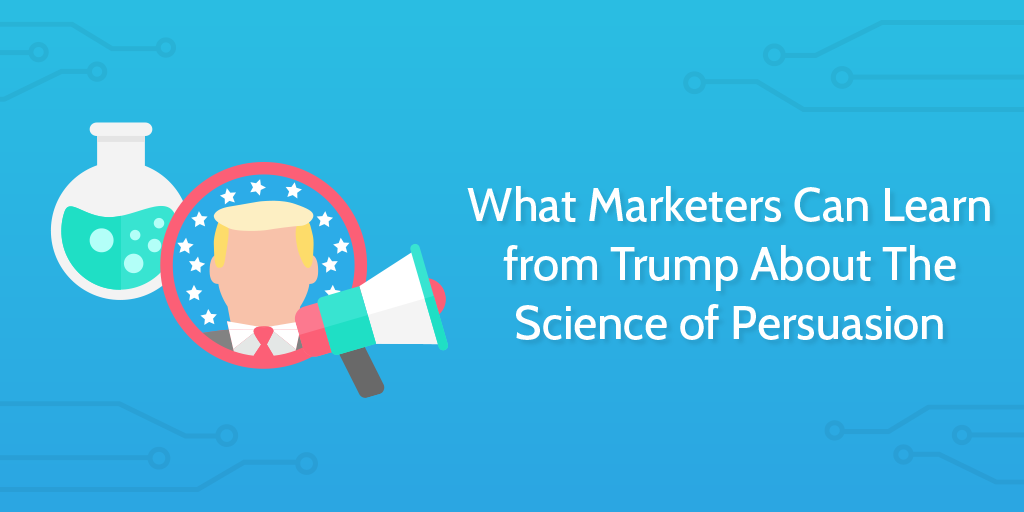 Recent elections have hogged the headlines due to their rhetoric and their politics.
Recent elections have hogged the headlines due to their rhetoric and their politics.
However, one consistent theme across both the Trump victory and the Brexit success was their use of advanced marketing techniques.
These campaigns utilized the power of emotion to drive their narratives and leveraged the complexities of Big Data to direct those messages at segmented groups with devastating effect.
The recent victories were not merely political successes, but demonstrations of the immense potential of advanced marketing and advertising methods.
We’ll look at three key areas in this article:
- Why are emotions so powerful in decision making?
- What is psychometric testing – the Trump and Brexit campaigns’ marketing method – and what can it tell us about our audience?
- How do we turn theory into actionable techniques?
The world of marketing is changing. Don’t get left behind.
Why emotion driven narratives are the way to sell any product
As with any brand, political parties must craft an image. This image should present a narrative to the public which the public can identify with and support.
Elon Musk forever talks about how his ultimate purpose is to save the species. He talks about grand plans and future dreams rather than what his companies are doing at the moment he’s talking. Instead of being a car manufacturer who wants to create an affordable electric car, he is a visionary who wants to transition the planet away from fossil fuels. Instead of being a rocket manufacturer who wants to decrease the cost of launching satellites, he’s trying to save the human race by terraforming Mars.

Elon Musk spins a narrative like no other. Though, he is helped by the fact that he seems entirely genuine in his convictions.
Dr. Drew Westen, professor of psychology at Emory university, believes successful politicians have been doing the same – and unsuccessful ones should have been…
Our brain is wired to promote emotionally driven decisions
Dr. Drew Westen’s views on the power of emotion became popular again after the election of Donald Trump, yet he was the subject of a feature in the New York Times 10 years before, making the very same points.
One of Westen’s primary pieces of research was a 2004 study where he measured participants’ neural responses to images of their favored politicians. He would present the participants with contradicting statements made by their candidate.
The initial reaction was for these neural networks to flare up – particularly, the right frontal lobe, the insula, and the amygdala; areas of the brain associated with distress and regulating emotions, shown in the image below.

In these moments of distress, the emotional areas of the brain would light up as the participant sought to deny or negate the contradiction presented to them, while the more rational parts of the brain remained quiet. Westen’s conclusion from extensive testing was that the emotional areas of the brain play a significantly larger role than we anticipate in how we form beliefs.
Moreover, once the participant was satisfied that they had resolved the contradiction presented to them, the brain rewarded itself with positive feelings – reinforcing the emotionally motivated decision.
This is not to say that rational and logical thinking doesn’t have sway over our opinions, but that the emotional areas of our brain are involved in the process to a far greater degree than we usually believe.
Brands use emotional narratives to create positive associations
According to Emolytics, a company who place emotion and the measuring of it central to understanding customer behavior, emotions play a huge role in any successful advertising campaign.
They quote Zig Ziglar, master salesman:
“People don’t buy for logical reasons. They buy for emotional reasons.”
Studies consistently show that emotions play a vital role in constructing memory, even to the extent that instigating emotion can add to the strength of the memories of emotionally neutral experiences directly after. It is no wonder then that brands work very hard to connect emotion with their products.
Coca Cola use positive emotions such as youth, family, and fun to sell their product. They also play on patriotism and their global position as a symbol of America overseas. McDonald’s does similar but with a greater focus on family.

Negative emotions, on the other hand, have been used to encourage people to quit cigarettes or to discourage behavior more generally. In politics, these have been used as attack campaigns against opposition candidates. Or in certain campaigns, these negative emotions have been used to bring certain policy issues to the center of political discourse.
This poster below was used to discourage people from staying within the EU and served as part of a larger wave of promotion which placed immigration at the center of the referendum debate. This encouraged the conflation of the EU’s principle of freedom of movement with an open door policy to the world. Many voters have declared their primary reason for voting leave was to stop immigration from non-EU countries. This poster may have been heavily criticized, but the broader campaign worked as planned.

The Remain campaign in Brexit also employed emotion, however, they shied away from going as far as the out-brigade. This poster below is an example of materials proposed by Saatchi&Saatchi which the Remain camp opted not to use for fear of poisoning the political discourse.

Where emotion was really championed was in the emerging world of ultra-targeted advertising. In these adverts, marketers are able to construct and convey the right emotions to the right people.
But how do we know who the right people are and how they will react to marketing materials?
Psychometrics.
What is psychometrics and why did Trump use it?
One of the interesting connections between the Trump campaign and the Brexit campaign, other than shared rhetoric, was the alleged involvement of communications firm Cambridge Analytica (CA) – of which allegedly Steve Bannon was formerly chairman of the board.

Both campaigns used psychometric profiling as one of their strategies to identify potential voters and to inform their approach and rhetoric in reaching certain groups.
The exact methodology employed by either campaign is not clear and hasn’t been published. Nonetheless, there are many things we know about this approach and many ways we can speculate it may have been implemented.
Psychometrics allow marketers to utilize big data to assess vast numbers of people and construct personality profiles on each according to frameworks like The Big Five (OCEAN approach) and the Need for Cognition Scale in order to pinpoint individuals most likely to convert.
Sorry, that’s a long sentence.
In short, marketers can minimize the number of people they have to reach in order to make a sale. This results in huge leaps in efficiency and, as a result, cost reduction.
Let’s look at the different parts of this one by one…
Big data
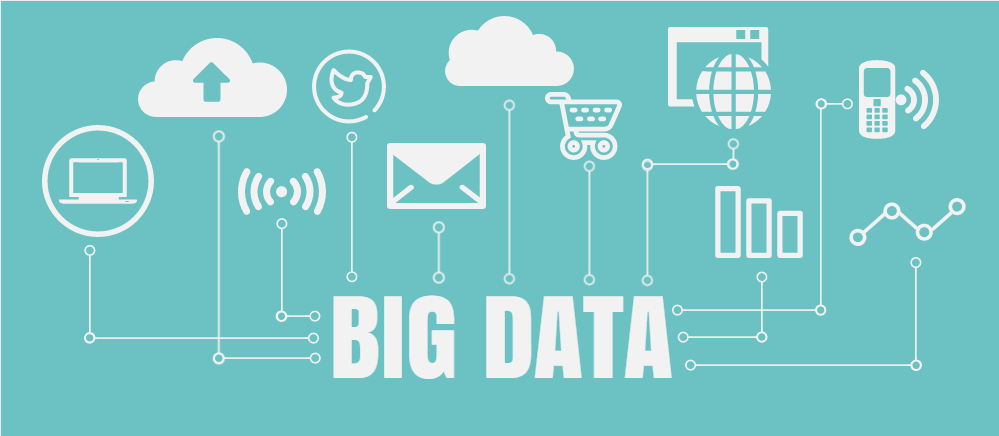 We’ll start with the vague term “Big Data”. The 2016 paper, Networks of Control, by Wolfie Christl and Sarah Spiekermann, provides a wealth of information to help us understand these methods and I’ll draw a number of examples from their work.
We’ll start with the vague term “Big Data”. The 2016 paper, Networks of Control, by Wolfie Christl and Sarah Spiekermann, provides a wealth of information to help us understand these methods and I’ll draw a number of examples from their work.
The ability to analyze huge amounts of data in order to take away understandings which would otherwise be obscured is generally referred to as Big Data. The term “big” is typically used to describe three key aspects:
- Volume – the increasing size of data
- Velocity – the increasing rate in which it is both produced and transmitted
- Variety – the increasing range of formats, variables, and representations
Big Data has been summarized by accounting firm McKinsey as:
“refer[ing] to datasets whose size is beyond the ability of typical database software tools to capture, store, manage, and analyze”
Cambridge Analytica, for example, claim to have 5,000 data points per person – and they’re talking about almost every person in the United States, plus many more worldwide.
It is in this vast treasure trove of information that we can find new knowledge about individuals and can parse that information in actionable ways.
The Big Five (OCEAN)

One key area employed within the elections is pulling vast data on voters and understanding that through the prism of a psychometric framework known as The Big Five.
This approach is centered around summarizing an individual’s personality through relation to five key categories. You can see them outlined in the table below:

We know this methodology is employed by Cambridge Analytica as their CEO Alexander Nix is pictured here below giving a presentation with the Big Five methodology taking center stage as one of the ways of understanding data.
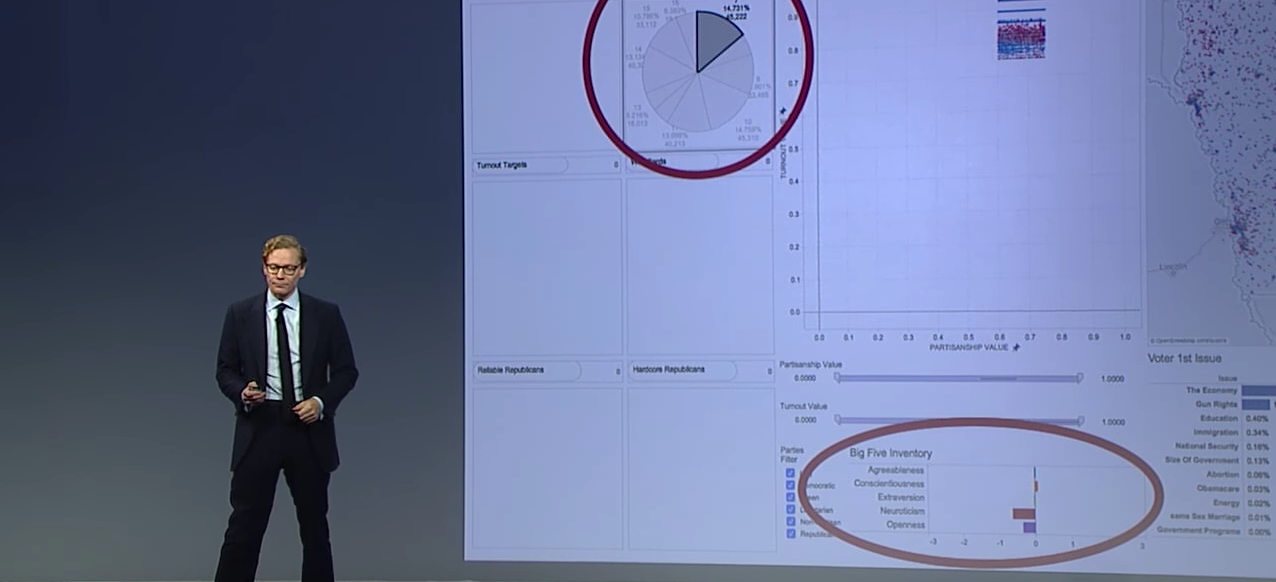
Nix is quoted as describing demographic targeting – the kind most businesses or politicians use to segment their audience – as:
“A really ridiculous idea. The idea that all women should receive the same message because of their gender—or all African-Americans because of their race.”
So what is the difference?
With demographic targeting, you may notice that your product has the most success when it’s targeting, for example, 18 – 24-year-old women who are native English speakers, speak a second language, and like to travel.
This form of targeting works really well if you’re trying to locate your customers. It works as a shorthand for finding people who like your product and are more likely to buy your product. Effective use of this strategy will help you reduce your customer acquisition cost/increase conversion rates/increase return on investment – whatever language you’re using to define your KPIs.
What it is not very good for, is converting people to your product. A politician in a US election needs to appeal to more than 65 million people in order to win the election. You need to find people susceptible to your product or message and be able to convert them. This is where the emotional mapping techniques offered through the Big Five methodology can help.
The Big Five in action
Michael Kosinski, when researching at Cambridge University, created an experiment where he posted a free-to-access psychometric test online to gather small amounts of data to inform his data analysis. This test went viral on Facebook and Kosinski was able to draw some powerful conclusions from his study.
You can see in the table below a summary of his data. With 170 likes per person, Kosinski’s methods were able to predict the following attributes with the connected rates of accuracy.
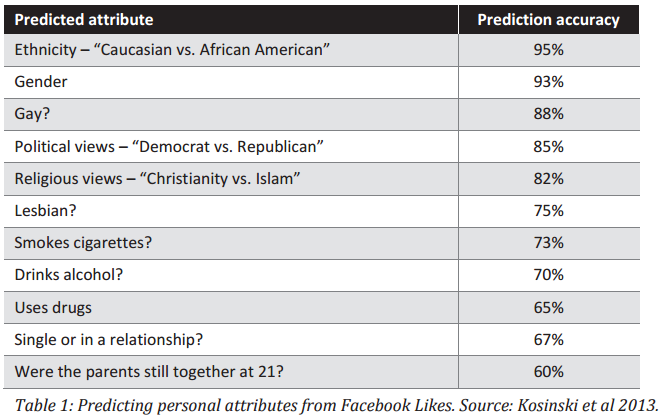
The more likes Kosinski’s model had for a person, the more accurately they could draw results and the more intimate those subjects were:
“Kosinski continued to work on the models incessantly: before long, he was able to evaluate a person better than the average work colleague, merely on the basis of ten Facebook “likes.” Seventy “likes” were enough to outdo what a person’s friends knew, 150 what their parents knew, and 300 “likes” what their partner knew. More “likes” could even surpass what a person thought they knew about themselves.”
This research done by Kosinski was allegedly leaked from Cambridge University by Aleksander Kugan and passed on to Strategic Communications Limited (SCL) – seemingly an overarching group under which many other organizations exist, including Cambridge Analytica.
SCL (or SCL affiliated entities) has been employed to influence elections all around the world and has also managed public relations efforts on behalf of NATO in war zones like Afghanistan.
With Kosinski’s research added to the substantial resources SCL and their groups have access to, a platform like Facebook is turned from being a database of people to a database of types of people.
The Need for Cognition Scale
The Big Five is not the only game in town. There are other ways to analyze the available data and make it actionable.
The Need for Cognition Scale is used in psychometrics to measure “the extent to which individuals are inclined towards effortful cognitive activities”, or feel “a need to understand and make reasonable the experiential world”.
This scale is used to understand how big an impact emotions make upon an individual’s decision-making process. Persons low on the Need for Cognition Scale tend to form their opinions based heavily on emotion.
People who score highly on the Need for Cognition scale are not necessarily more likely to act or think more rationally, but are more highly disposed to rationalizing or hypothesizing to justify their decisions.
Richard Fording and Sanford Schram, reporting on their own research paper in the Washington Post, describe a category of voter which they label the Low Information Voter:
“Low information voters are those who do not know certain basic facts about government and lack what psychologists call a “need for cognition.” Those with a high need for cognition have a positive attitude toward tasks that require reasoning and effortful thinking and are, therefore, more likely to invest the time and resources to do so when evaluating complex issues.”
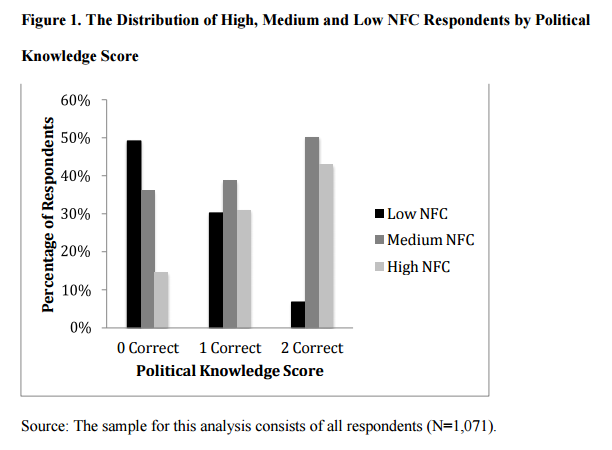
According to their research, Trump was performing very well with this category of voters. That is not to suggest that all Trump voters fall into that category!
A conclusion we can pull from this, however, is that voters who score poorly on the Need for Cognition Scale are likely easier targets to sell political ideas to. They are the easiest group of floating voters to target and capture.
A video from Sky news reporting on Cambridge Analytica seemed to present evidence that CA had been factoring Need for Cognition into their analysis. The video has since been removed from YouTube, however, we do have the screenshot from the video below:

In the video, we can see an analyst pouring over a research paper. The paper is entitled Method Effects and the Need for Cognition Scale. The relevant section pictured in the screenshot can be seen in the image below:
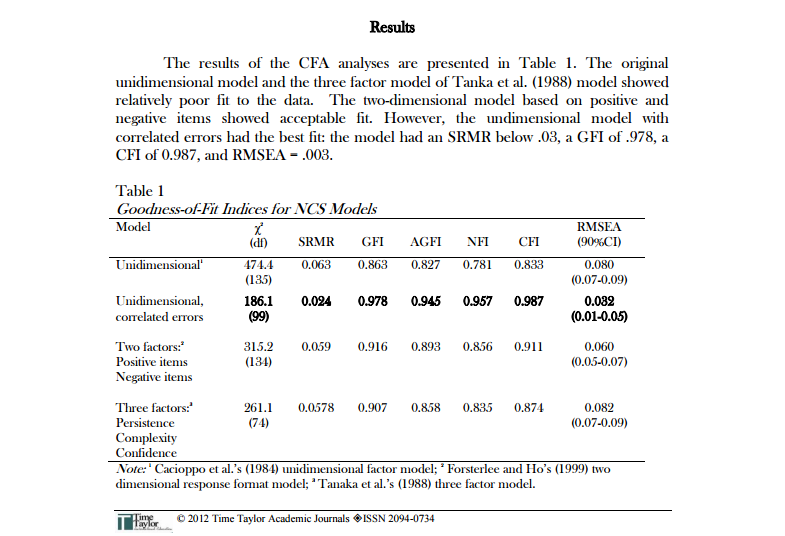
Papers-shown-in-videos might seem to be clutching at straws, but the effectiveness of aligning an emotional map of someone’s personality with the knowledge of their place on a scale of susceptibility to persuasion has the potential for devastatingly effective results…
How do we turn the theory into practice?
At this point, we would be speculating on the methodology used by Cambridge Analytica or any other SCL affiliated group to gather the huge amounts of data they’re acting upon.
However, the services of these firms and others like them are commercially available and not all are so secretive.
One firm which fits within this category is VisualDNA. This company claims to be able to reach huge numbers of people across the world whom they have complex and extensive data on. According to Christl and Speikermann, VisualDNA gathered their data by creating online games and quizzes which users took voluntarily.
These games would involve psychometric tests used to determine users’ individual profiles. They then use these results to help large companies target their advertising more effectively. They are able to segment individuals via a broad range of different frameworks:
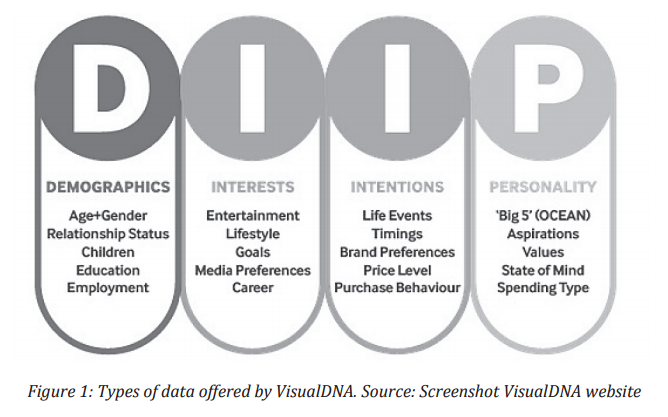
From a recent whitepaper published by VisualDNA, they claim:
“When it comes to connecting with your audience, it’s emotionally intelligent creative that makes the magic happen—and the OCEAN model offers a powerful way to identify messages that will resonate with individual members of your audience.”
In short, the tools these companies use to target individuals, whether on behalf of companies or political parties, provide the most advanced means of targeting. Through creating content able to appeal to the right emotional triggers and then targeting that content at those most susceptible to it, the conversion rates will increase dramatically as the cost per conversion reduces.
The way psychometric targeting is revolutionizing communication between organizations and individuals means those who fail to employ it will get left behind.
Whether through employing an external contractor or establishing an in-house department dedicated to this approach, political parties and large organizations cannot afford to neglect the opportunities this method presents.
But how do we act on the data we’ve gathered?
How to build custom audiences on Facebook
There are multiple large advertising options online with Facebook and Google representing the two most powerful and commonly used.
We’ll focus on Facebook advertising to provide a clear example of how you can act upon the segmented data you have gathered.
If you have gathered customer information including email and “likes” from Facebook in a way similar to VisualDNA, then this guide would provide an ideal method. When someone opts to play a game in Facebook or use the “login with Facebook” option on a website, they are asked to accept that the third party service will have access to certain public and private information.
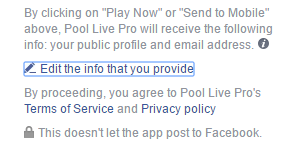
If my privacy settings are low then this game will be able to record my Facebook identity, label it to my email address, and access all my whopping 580 “likes”. Enough, according to the Kosinski research, to know me better than I know myself.
Once you have analyzed my data, and that of all other respondents you’ve collected, you can categorize the individual profiles within lists.
Perhaps List1 are all the people who you think will want to buy a bike. List2 is the people who might want to buy a scooter. List3 is people you think are more interested in buying a skateboard.
You would then create 3 different Facebook custom audiences, uploading a different email list for each. Here’s the process:
- Choose the list of people you want to upload and know the purpose of that list.
- Save your list in either CSV or TXT format.
- Go to the Audiences tab in your Advert manager in Facebook.
- Choose Create Audience, then Custom Audience, and then choose Customer File.
- Upload the CSV or TXT file.
- In about 30 minutes, depending on the size, Facebook will have created your Custom Audience.
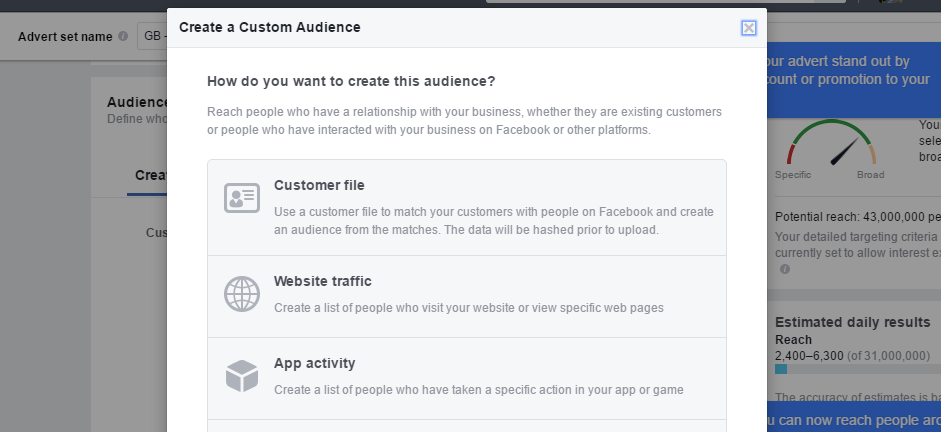
Now you can create three custom audiences, one for people who like bikes, one for skateboards, and one for scooters. Meaning you can create content specially tailored to each based on your psychometric data, and you’re not wasting money shooting adverts to people who are not interested.
Companies are using targeted Facebook advertising all the time. With the addition of psychometric understandings of the individual customers, companies and political entities can maximize the efficiency of their reach and sway over public opinion.
Custom Trump audiences
During the election, Jared Kushner, working as the head of Trump’s social media team, set up a 100 person strong data center hidden away in a warehouse. Their job was to use digital marketers as the front line for political warfare.
The Trump campaign used micro-targeting for political promotion and political fundraising.
Kushner used this approach to boost the sales of Trump merchandise, increasing the daily revenue of the campaign from $8,000 to $80,000.
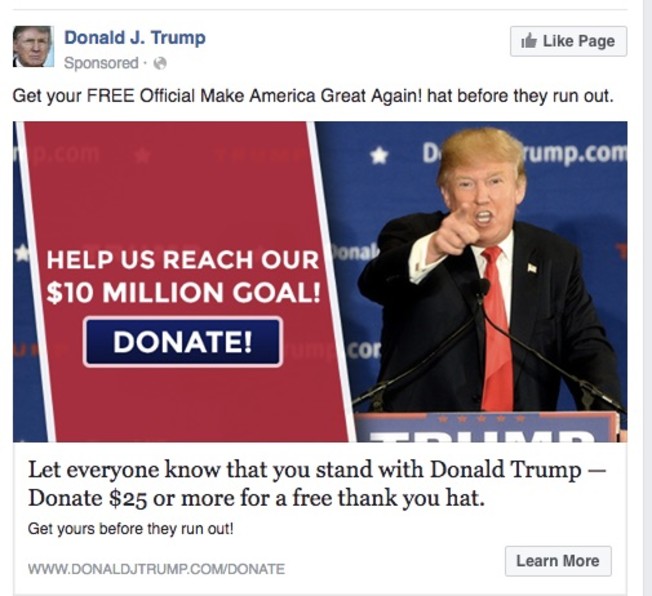
He also ran tests with simple videos. He would promote a short video of Trump speaking to camera in a very lo-fi way and see to what extent he could maximize watches. Kushner’s work paid off as his first test video ended up with 74 million views across the major video platforms after a spend of $160,000.
Use the science of persuasion or be left behind
The key takeaway from the Trump campaign’s use of advanced digital marketing strategies can be found in this quote from Steven Bertoni, writing for Forbes:
“FEC filings through mid-October indicate the Trump campaign spent roughly half as much as the Clinton campaign did.”
Consider, the Trump campaign were not the only ones employing digital marketing and leveraging big data in inventive ways. Yet their conversion rates were considerably better.
Maybe it’s just politics.
Before you dismiss it too quickly, here’s a case study of VisualDNA’s work with a leading health and beauty company in the US:
Each segment received tailored creative. Because people with high openness are generally more willing to take risks and experiment, the brand sent them a bold, confronting message: “Give two fingers to convention”. At the other end of the spectrum, members of the audience identified as having low extraversion received a softer sell: “Beauty doesn’t have to shout.”
By matching the right creative with the right audience, this leading brand inspired over 1,000 customers to purchase, and boosted ROI by a massive 56 percent compared with a control group.
Get the right message to the right audience and your products or services will always find more success.
Have you employed psychometrics within your marketing? Let us know in the comments below and subscribe to the blog to make sure you don’t miss out on our in-depth guide to creating custom audience Facebook campaigns which will be coming very soon is available here: How to Use Facebook Retargeting and Custom Audiences to Drive Sales.







Adam Henshall
I manage the content for Process Street and dabble in other projects inc language exchange app Idyoma on the side. Living in Sevilla in the south of Spain, my current hobby is learning Spanish! @adam_h_h on Twitter. Subscribe to my email newsletter here on Substack: Trust The Process. Or come join the conversation on Reddit at r/ProcessManagement.